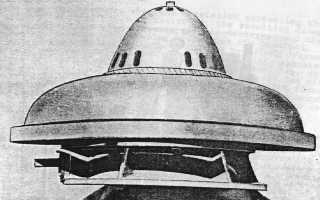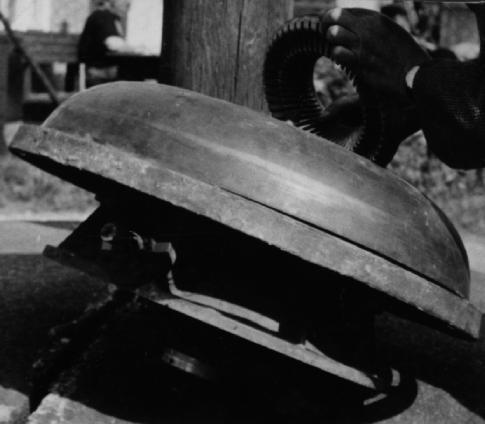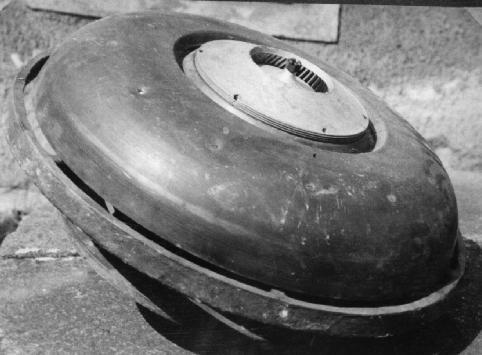


Among Viktor Schaubergers machines there is no one like the Repulsin or the flying saucer that has created such myths and stories. The basic designs are from the mid thirties when he tried to finish the Climator. A most peculiar thing is that they seem to be very difficult to control, as they have a habit of smashing into the ceiling, and after that,being irreparable. Viktor himself claimed that powerful diamagnetic forces were responsible for the enormous effect. However, in the literature and in Viktor’s own notebooks there is no evidence, if and if so how these devices worked. The question is, are all these rumours true ? Do these devices really work ? Well, what we can see from the few pictures that exist is that there seems to be some kind of turbine,shaped as a double flat membrane with concentric rills on it. The double membrane was probably co-rotating as four bolts that fix them together,can be observed. In the pictures we can also see that there is some kind of body, a bowl shaped plate that is bend over the membrane whose outlet can be found inside the rim foil. Together, the rim foil (the metal band around the lower rim) and the outlet form a Venturi"tube". An air intake can be seen on the top of the device. Unfortunately,one important component is missing on the top. This component should "pre-form"the air so it starts to twist before it enters the double membrane. This component had a similar shape as a sea shell. Viktor said that this device was never built as it is very difficult to produce a thing with such a complex geometry. In the book Living Water (by Olof Alexandersson) a colloid solution of very fine grained quartz crystal and water is mentioned as a catalyst for the process.


Repulsin type B, inner part ofair inlet removed.So, if we start to think for a while.Let’s say that this device really worked, it really did take off!How would it work ?
As I mentioned before there is one (at least) explanation on why Viktor Schaubergers machine took off with such power. It might be explained by "normal" aerodynamics anda phenomena named ‘the Coanda effect’. Very brief the Coanda effect is the phenomena when a flowing media tends to "stick" to a curved surface,You can reada biography of Henri Coanda here. If we take a closer look on the bowl shaped plate, we realise that it is a circular wing. When the air is rushing out inside the foil or the metal band that can be seen on the lower rim of the device it creates a sub pressure just over the foil.
The surrounding air is sucked inside the foil and with the air from the membranes. This generates a low pressure over the device and the device is "hanging" in it. You could say that it is an inverted hovercraft. But instead of creating a pressure underthe craft You create a low pressure over it. Basically it is the same, it is only a matter of pressure differences. The low pressure is modest but as we have a large area we also get a huge lifting force. There is one more way to create the low pressure over the craft. You can let the air blow out on the top instead.

When the twisted air follows the Coanda surface it sweeps down the surrounding air and we get the increased air flow this way lowering the pressure. If You want to read more about the Coanda effect follow this link. On this page You can read a lot about different applications and a very interesting new type of fan, theJet Fan.
 In Boston people have started to create other types of Coanda "flying saucers"
In Boston people have started to create other types of Coanda "flying saucers"


